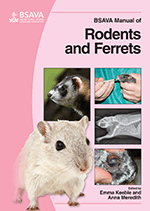
Full text loading...

Although interspecies differences exist in gastrointestinal anatomy, physiology and disease predisposition, dysfunction of the rodent gut is usually characterized by abnormalities in motility, secretion and/or the composition of the microbial flora. It is important to understand these general processes because, regardless of the definitive diagnosis, a critical component of therapy is supportive and aimed at restoring these functions. Moreover, many gastrointestinal disorders are multifactorial in origin and approaching the problem from first principles will facilitate diagnosis and formulation of an appropriate therapeutic plan. The chapter observes Disruption to motility; General approach to rodent gastroenteropathies; Common gastrointestinal diseases in mice, rats, hamsters, gerbils, guinea pigs, chinchillas and degus.
Rodents: digestive system disorders, Page 1 of 1
< Previous page | Next page > /docserver/preview/fulltext/10.22233/9781905319565/9781905319565.11-1.gif

Full text loading...













